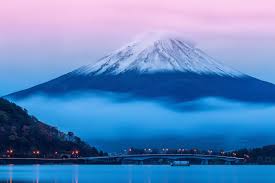Mount Fuji:

Japan’s Mount Fuji remained snow-less recently, the latest date that its majestic slopes have been bare since records began 130 years ago.
- Mount Fuji, also known as Fuji-san, is the highest mountain in Japan, standing at 3,776 meters.
- It is situated close to the Pacific coast in the Yamanashi and Shizuoka prefectures in the heart of the large island of Honshu, about 100km to the southwest of the Tokyo-Yokohama metropolitan area.
- Unlike other famous high-elevation mountains in the world, Mt. Fuji is not part of a large mountain range.
- It is a stratovolcanothat has been dormant since its last eruption in 1707 but is still generally classified as active by geologists.
- It has a prominent summit craterand is constructed from innumerable basaltic lava flows, each a few meters thick.
- It has a smooth slope and a wide, spreading base, creating a beautiful skyline as it narrows to a magnificent peak.
- It is said that the main cause of Mt. Fuji’s volcanic activity is the Pacific Plate sinking under the bottom of the Philippine Plate.
- On the northern slopes of Mount Fuji lie the Fuji Five Lakes (Fuji Goko), comprising, east to west, Lake Yamanaka, Lake Kawaguchi, Lake Sai, Lake Shōji, and Lake Motosu, all formed by the damming effects of lava flows.
- Despite its active volcanic nature, Fuji’s summit is covered in snow most times of the year.
- The mountain is the major feature of Fuji-Hakone-Izu National Park, and it is at the centre of a UNESCO World Heritage site designated in 2013.




